Flights of Fancy (Part 25): More Airwave Air Traffic, and Flight in a New “Format”
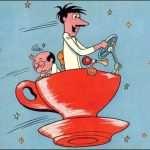
 In the 1963-64 season, Hanna-Barbera would introduce its “New Cartoon Show” syndication package consisting of Wally Gator, Lippy the Lion and Hardy Har Har, and Touche Turtle cartoons, in plot-restrictive five minute running lengths. On at least half of the occasions when aviation was involved, these would follow in the tradition of earlier studio efforts, by using helicopters instead of planes. Among these included Touche’s Out of This Whirl, where Touche plays a game of helicopter hide-and-seek with The Great Granooka, a martian leader determined to drive off the air a kids’ show host impersonating a Martian, for giving the planet a bad name. Granooka’s disintegration gun zaps the wheels off Touche’s copter, and the turtle and Dum Dim take cover in a cloud to make a creeping getaway. Another shot disintegrates the cloud, and a third zaps away the copter entirely. Granooka succeeds in his mission, but achieves unintentional fame as the obvious replacement for the kids’ show host, in a Western titled “Have Gun, Will Disintegrate.”
In the 1963-64 season, Hanna-Barbera would introduce its “New Cartoon Show” syndication package consisting of Wally Gator, Lippy the Lion and Hardy Har Har, and Touche Turtle cartoons, in plot-restrictive five minute running lengths. On at least half of the occasions when aviation was involved, these would follow in the tradition of earlier studio efforts, by using helicopters instead of planes. Among these included Touche’s Out of This Whirl, where Touche plays a game of helicopter hide-and-seek with The Great Granooka, a martian leader determined to drive off the air a kids’ show host impersonating a Martian, for giving the planet a bad name. Granooka’s disintegration gun zaps the wheels off Touche’s copter, and the turtle and Dum Dim take cover in a cloud to make a creeping getaway. Another shot disintegrates the cloud, and a third zaps away the copter entirely. Granooka succeeds in his mission, but achieves unintentional fame as the obvious replacement for the kids’ show host, in a Western titled “Have Gun, Will Disintegrate.”
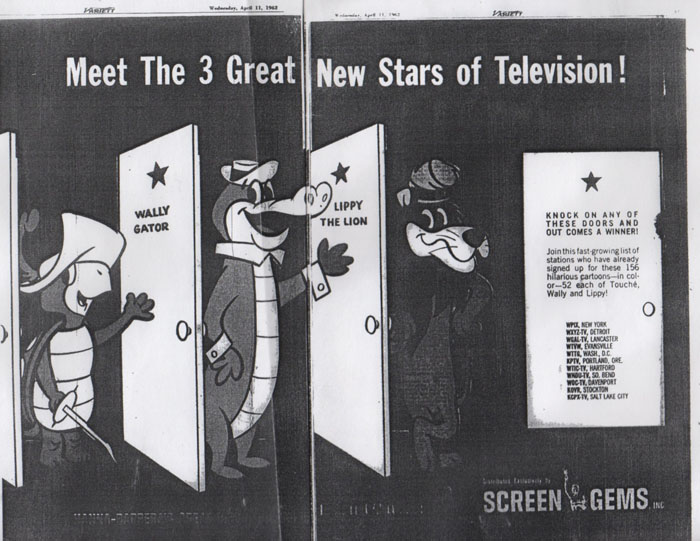
In Lippy and Hardy’s Bird in the Hand, the boys turn desperate for their next meal, and stoop to answering a want ad for an actual job. The City Museum wants adventurers to capture a live dodo bird sighted on an uncharted island. The fowl is identical in design to Ruff and Reddy’s Chickasaurus, only white. Our heroes commute by helicopter, and after surviving the bird’s practical jokes (such as pushing huge boulders off of cliffs, and rigging a tree nest as a giant slingshot), fool her into friendship by disguising Hardy as another dodo (though Hardy complains that retaining the bird’s ever-present ear to ear grin makes his face hurt). But the bird is too big for the helicopter, so Lippy tows her and her egg in on a rope like a hang glider. Lippy’s $10,000 fee disappears quickly, however, as the dodo’s egg hatches a the museum, producing a whole brood of chicks. “Dodos are now a dime a dozen”, says the museum curator. “So it shouldn’t be a total loss,” responds Lippy, “gimme the dime.”
 Our lion and hyena face bigger peril in Bye-Bye Fly-Guy, as aerial stowaways attempting to escape winter’s cold by reaching California sunshine. They hide in a crate being loaded aboard a cargo plane – carrying a shipment of dynamite. (Is this FAA approved cargo?) Lippy gets hungry en route, and braves asking the pilot for “a bite”. When asked this question by a lion, the pilot doesn’t think twice, and parachutes out, expressing his opinion that hauling dynamite is one thing, but at hauling lions he draws the line. Lippy finds himself at the controls, while Hardy breaks into the usual moaning panic. Lippy looks at the bright side: if they crash and the dynamite blows them to kingdom come, at least there’ll be no evidence left for anyone to pin the blame on them for the crash. The plane briefly comes to an unexpected stop, and Lippy assumes they have somehow landed. Instead, the belly of the plane is caught on the flagpole of a mile-high skyscraper, and Lippy almost exits the plane into thin air. Somehow getting the plane loose and going again, Lippy encounters a thick fog cover, and can’t explain to Hardy the unexpected sound of a foghorn in close proximity. The explanation is actually simple – he’s flying so low, he just passed a lighthouse, and plunges the plane into the ocean, proceeding submerged much like Magoo in “Mister Magoo’s Puddle Jumper”. Hardy complains that the fog is getting cold and clammy, until the plane stops, embedded in the ocean bottom. Lippy again assumes they’ve landed, and opens the cargo door, flooding the plane. “You know the old saying. Any landing ya can swim away from is a good landing”, bubbles Lippy. Astride a raft of the water-logged dynamite crates, the two float on the open sea. Hardy moans that they’ll never be found out here, but Lippy, ever the optimist, notes that while it might not be the land of sunshine he promised, they’re still getting plenty of sun.
Our lion and hyena face bigger peril in Bye-Bye Fly-Guy, as aerial stowaways attempting to escape winter’s cold by reaching California sunshine. They hide in a crate being loaded aboard a cargo plane – carrying a shipment of dynamite. (Is this FAA approved cargo?) Lippy gets hungry en route, and braves asking the pilot for “a bite”. When asked this question by a lion, the pilot doesn’t think twice, and parachutes out, expressing his opinion that hauling dynamite is one thing, but at hauling lions he draws the line. Lippy finds himself at the controls, while Hardy breaks into the usual moaning panic. Lippy looks at the bright side: if they crash and the dynamite blows them to kingdom come, at least there’ll be no evidence left for anyone to pin the blame on them for the crash. The plane briefly comes to an unexpected stop, and Lippy assumes they have somehow landed. Instead, the belly of the plane is caught on the flagpole of a mile-high skyscraper, and Lippy almost exits the plane into thin air. Somehow getting the plane loose and going again, Lippy encounters a thick fog cover, and can’t explain to Hardy the unexpected sound of a foghorn in close proximity. The explanation is actually simple – he’s flying so low, he just passed a lighthouse, and plunges the plane into the ocean, proceeding submerged much like Magoo in “Mister Magoo’s Puddle Jumper”. Hardy complains that the fog is getting cold and clammy, until the plane stops, embedded in the ocean bottom. Lippy again assumes they’ve landed, and opens the cargo door, flooding the plane. “You know the old saying. Any landing ya can swim away from is a good landing”, bubbles Lippy. Astride a raft of the water-logged dynamite crates, the two float on the open sea. Hardy moans that they’ll never be found out here, but Lippy, ever the optimist, notes that while it might not be the land of sunshine he promised, they’re still getting plenty of sun.
 Wally Gator also enjoys(?) a brief flight in Ice Cube Boob, where he stows away as cargo in a flimsy crate of his own making, on a flight to Paris, France via the polar route (in a carrier coincidentally called “H.B. Air Freight”). Ignoring Wally’s “This End Up” tag on the crate, the shippers leave Wally to spend the whole flight in the cargo bay upside down, vowing to never again fly fourth class. The flight hits some rough weather over the pole, causing it to lose altitude. To avoid a crash, the plane jettisons its cargo, and Wally winds up in the frozen North. After a rough encounter with a polar bear, he freezes into an ice cube. An explorer professor discovers him, and believes he is a fossil from the ice age. Wally is transported on ice back to the States (upside down again), but is carelessly left to thaw out during a news interview with the professor. He becomes famous as a living prehistoric monster, until Mr. Twiddle recognizes him on TV, and drags him back to the humdrum world of his home sweet zoo. But Twiddle has a new respect for Wally as a celebrity, and provides the gator with the satisfaction of asking for his autograph.
Wally Gator also enjoys(?) a brief flight in Ice Cube Boob, where he stows away as cargo in a flimsy crate of his own making, on a flight to Paris, France via the polar route (in a carrier coincidentally called “H.B. Air Freight”). Ignoring Wally’s “This End Up” tag on the crate, the shippers leave Wally to spend the whole flight in the cargo bay upside down, vowing to never again fly fourth class. The flight hits some rough weather over the pole, causing it to lose altitude. To avoid a crash, the plane jettisons its cargo, and Wally winds up in the frozen North. After a rough encounter with a polar bear, he freezes into an ice cube. An explorer professor discovers him, and believes he is a fossil from the ice age. Wally is transported on ice back to the States (upside down again), but is carelessly left to thaw out during a news interview with the professor. He becomes famous as a living prehistoric monster, until Mr. Twiddle recognizes him on TV, and drags him back to the humdrum world of his home sweet zoo. But Twiddle has a new respect for Wally as a celebrity, and provides the gator with the satisfaction of asking for his autograph.
 Magilla Gorilla is next to hit the sky lanes, in High Fly Guy (10/30/65). Mr. Peebles sends Magilla to the supermarket for bananas to keep him occupied. Magilla has enough change left over for a ride on the store’s new coin-operated kiddie ride – a miniatire plane on a pivoting mount. He jumps in a bit too eagerly, jostling the ride so that its power cord is pulled out of the wall socket. Attempting to replug it in, Magilla chooses a socket reading “High Voltage” instead of “DC”. (Amazing how the plug sizes just happen to match perfectly between the two outlets.) Magilla inserts his dime, and the super-charged prop engine not only generates enough force to rip the craft from its plug and mounting, but retains enough charge for an extended flight. Having no idea how this ride gives you so much for your money’s worth, Magilla decides to settle back and enjoy it. With no control stick, the plane chooses its own course, much like the Pink Panther’s flight in “Jet Pink”. It performs a series of loops predicting the Panther’s flight, then soars over the site of a film shoot, where two biplanes are about to dogfight for the epic, “Return of the Son of the Hero of the Eagle Squadron”. Magilla narrowly misses collision in the crossing paths of the biplanes, and complains there ought to be a traffic cop up here. The propeller of one of the planes begins to bear down upon his neck, only inches away. Magilla’s plane performs an inside loop, dumping the gorilla into the cockpit of the biplane. As Magilla dangles with his feet out a hole in the cockpit floor, he apologizes to the pilot that he is “just passing through”, and falls out the bottom. He lands in the second biplane’s cockpit. “A gorilla?”, questions the second pilot – “I’m gonna have to start reading these scripts.” Another loop without a seat belt, and Magilla is deposited back into his own plane. The two biplanes converge upon him, but Magilla rises out of their path, causing the two planes to grind themselves away to bare engine blocks with their propellers – to the satisfaction of the studio cameraman, who calls it the greatest stunt ever filmed.
Magilla Gorilla is next to hit the sky lanes, in High Fly Guy (10/30/65). Mr. Peebles sends Magilla to the supermarket for bananas to keep him occupied. Magilla has enough change left over for a ride on the store’s new coin-operated kiddie ride – a miniatire plane on a pivoting mount. He jumps in a bit too eagerly, jostling the ride so that its power cord is pulled out of the wall socket. Attempting to replug it in, Magilla chooses a socket reading “High Voltage” instead of “DC”. (Amazing how the plug sizes just happen to match perfectly between the two outlets.) Magilla inserts his dime, and the super-charged prop engine not only generates enough force to rip the craft from its plug and mounting, but retains enough charge for an extended flight. Having no idea how this ride gives you so much for your money’s worth, Magilla decides to settle back and enjoy it. With no control stick, the plane chooses its own course, much like the Pink Panther’s flight in “Jet Pink”. It performs a series of loops predicting the Panther’s flight, then soars over the site of a film shoot, where two biplanes are about to dogfight for the epic, “Return of the Son of the Hero of the Eagle Squadron”. Magilla narrowly misses collision in the crossing paths of the biplanes, and complains there ought to be a traffic cop up here. The propeller of one of the planes begins to bear down upon his neck, only inches away. Magilla’s plane performs an inside loop, dumping the gorilla into the cockpit of the biplane. As Magilla dangles with his feet out a hole in the cockpit floor, he apologizes to the pilot that he is “just passing through”, and falls out the bottom. He lands in the second biplane’s cockpit. “A gorilla?”, questions the second pilot – “I’m gonna have to start reading these scripts.” Another loop without a seat belt, and Magilla is deposited back into his own plane. The two biplanes converge upon him, but Magilla rises out of their path, causing the two planes to grind themselves away to bare engine blocks with their propellers – to the satisfaction of the studio cameraman, who calls it the greatest stunt ever filmed.
 Magilla next enters the airspace of the local airport. As Magilla has no radio, the control tower tries to talk him down on a P.A. system. “Try turning downwind toward the wind sock.” Magilla’s plane is so small, he flies right into, and out the toe, of the sock. “Look, pal, why don’t you just turn around and fly away like a nice guy?”, begs the controller. Magilla’s response is to crash right through both sides of the tower’s windows. “This used to be such a quiet airport”, says the controller. Magilla apologizes for his lack of air brakes. Magilla’s next destination is Glick’s Department Store, crashing through an upper story window. “May I help you, sir?”, asks a clerk. “No thanks. Just browsing” answers Magilla. Customers believe he is a new item from the toy department. Another clerk denies that they carry any flying gorillas, just as Magilla emerges from an elevator. “What was that?”. complains a lady customer, “Peter Potamus and his magic flying balloon?” After scooping a passenger off an escalator, Magilla finally busts out of the store through another window. His ride finally comes to an abrupt conclusion, as the engine stalls, and Magilla realizes his dime is up. The bedraggled gorilla returns to the supermarket, wearing the remains of the wrecked plane ride around his waist. Peebles is waiting, and when Magilla spins his wild tale of adventure, Peebles stuffs a bar of soap in his mouth to wash it out for telling a fib. But Magilla keeps recounting his exploits, filling the screen with soap bubbles, for the fade out.
Magilla next enters the airspace of the local airport. As Magilla has no radio, the control tower tries to talk him down on a P.A. system. “Try turning downwind toward the wind sock.” Magilla’s plane is so small, he flies right into, and out the toe, of the sock. “Look, pal, why don’t you just turn around and fly away like a nice guy?”, begs the controller. Magilla’s response is to crash right through both sides of the tower’s windows. “This used to be such a quiet airport”, says the controller. Magilla apologizes for his lack of air brakes. Magilla’s next destination is Glick’s Department Store, crashing through an upper story window. “May I help you, sir?”, asks a clerk. “No thanks. Just browsing” answers Magilla. Customers believe he is a new item from the toy department. Another clerk denies that they carry any flying gorillas, just as Magilla emerges from an elevator. “What was that?”. complains a lady customer, “Peter Potamus and his magic flying balloon?” After scooping a passenger off an escalator, Magilla finally busts out of the store through another window. His ride finally comes to an abrupt conclusion, as the engine stalls, and Magilla realizes his dime is up. The bedraggled gorilla returns to the supermarket, wearing the remains of the wrecked plane ride around his waist. Peebles is waiting, and when Magilla spins his wild tale of adventure, Peebles stuffs a bar of soap in his mouth to wash it out for telling a fib. But Magilla keeps recounting his exploits, filling the screen with soap bubbles, for the fade out.
 Secret Squirrel would follow the lead of The Jetsons, in making semi-regular use of a top secret spy car that can sprout wings to become a plane. (A later Hanna-Barbera records album, Super Snooper in James Bomb, would take the idea one better, with its nominal secret agent flying a solid gold Rolls Royce that sprouts wings, but has trouble gaining altitude because of its weight, requiring the jettisoning of all luxury equipment when an emergency arises – including pool table, baby grand piano, snack bar, and kitchen sink.)
Secret Squirrel would follow the lead of The Jetsons, in making semi-regular use of a top secret spy car that can sprout wings to become a plane. (A later Hanna-Barbera records album, Super Snooper in James Bomb, would take the idea one better, with its nominal secret agent flying a solid gold Rolls Royce that sprouts wings, but has trouble gaining altitude because of its weight, requiring the jettisoning of all luxury equipment when an emergency arises – including pool table, baby grand piano, snack bar, and kitchen sink.)
Fast forward a few years, and a hit movie from Warner Brothers provided the inspiration for a new H-B creation. Blake Edwards’ The Great Race, a melodrama spoof about a round the world race from New York to Paris in the days of early motoring, gave H-B the idea to create a Victorian-style moustached villain (Dick Dastardly), and his canine sidekick Muttley, yet keep things up to date by placing them in a modern-day series of cross-country road rallies, known as the Wacky Races. A broad array of contenders were developed to provide competition, driving everything from traditional racing cars to converted Army tanks, buzzsaws, and even a boulder for the prehistoric Slag Brothers. Two entries could attain flight when needed. The Red Max (play on the film title “The Blue Max”, recently popular in theaters) drove – or is it flew? – a “car” which looked more like a red WWI biplane, known as the “Crimson Haybaler”. Professor Pat Pending also had a vehicle of his own creation – the “Convert-a-Car”, which could transform into virtually any kind of device to fit the need or occasion – including a large attachment for – what else – a helicopter propeller.
 When the aforementioned series ran its course of allotted episodes, the popularity of Dick Dastardly led the studio to create a spinoff, also based upon a popular feature of the day. From England had come a sort of aerial knock-off of “The Great Race”, imported to the states through 20th Century Fox, entitled, Those Magnificent Men in Their Flying Machines. Without much modification of title, the idea became “Dastardley and Muttley in Their Flying Machines”. The entire show was pure formula – as much borrowing from the aforementioned British feature as from the Road Runner. Dastardley is cast in WWI, as leader of the German “Vulture Squadron”, with a singular mission as the reason for its existence – stop the courier deliveries of messages by Yankee Doodle Pigeon – a characterless fowl with far less personality than the Road Runner, who toots on a small bugle instead of crying “Beep Beep”. Dastardley recruits two new characters – Zilly, a spineless weakling, who would rather hide inside his flight uniform like a turtle pulling his head into his shell than face danger, and Klunk, mechanic and inventor of the squadron, whose time is spent developing new weaponry a la Wile E. Coyote to capture or destroy the pigeon. Klunk’s primary character trait is an inability to say anything in complete sentences, his dialogue breaking into weird vocalized sound effects, needing to be verbally translated by Zilly. (This repetitious translation bit would often slow down the pace of episodes considerably – something desirable to the producers, allowing them to eat up air time without expending more bucks on animating the aerial stunts). Had the series been able to afford a theatrical budget, it might have amounted to a reasonable facsimile of its WB counterpart, as many of the devices installed by Klunk in the squadron’s planes (giant slingshots, claw extenders, etc.) bear striking resemblance to the cleverness of Wile E.’s gadgets. However, pacing was deadened by building whole episodes around only one or two of these inventions at a time – filling most of the remaining air-time with needless chatter and repetitious angry calls from Dastardley’s commander. Rest assured that the pigeon was never “stopped”, as the series’ outrageously-repetitious theme song engrained in our heads, leaving Muttley ample opportunity in every episode to react to the failed outcomes with his trademark sarcastic snicker. Audiences endured the series for its relatively short run, in hopes of greatness that never materialized. In retrospect, the series has not aged well. Perhaps the most pointed commentary on its legacy came from the late days of the studio itself, in an episode of “Yogi’s Treasure Hunt”, where captive Snooper and Blabber are subjected to torture by being forced to sit and watch the complete run of this series! Snooper wails that enduring such cruelty will “turn our brains into toothy-paste.”
When the aforementioned series ran its course of allotted episodes, the popularity of Dick Dastardly led the studio to create a spinoff, also based upon a popular feature of the day. From England had come a sort of aerial knock-off of “The Great Race”, imported to the states through 20th Century Fox, entitled, Those Magnificent Men in Their Flying Machines. Without much modification of title, the idea became “Dastardley and Muttley in Their Flying Machines”. The entire show was pure formula – as much borrowing from the aforementioned British feature as from the Road Runner. Dastardley is cast in WWI, as leader of the German “Vulture Squadron”, with a singular mission as the reason for its existence – stop the courier deliveries of messages by Yankee Doodle Pigeon – a characterless fowl with far less personality than the Road Runner, who toots on a small bugle instead of crying “Beep Beep”. Dastardley recruits two new characters – Zilly, a spineless weakling, who would rather hide inside his flight uniform like a turtle pulling his head into his shell than face danger, and Klunk, mechanic and inventor of the squadron, whose time is spent developing new weaponry a la Wile E. Coyote to capture or destroy the pigeon. Klunk’s primary character trait is an inability to say anything in complete sentences, his dialogue breaking into weird vocalized sound effects, needing to be verbally translated by Zilly. (This repetitious translation bit would often slow down the pace of episodes considerably – something desirable to the producers, allowing them to eat up air time without expending more bucks on animating the aerial stunts). Had the series been able to afford a theatrical budget, it might have amounted to a reasonable facsimile of its WB counterpart, as many of the devices installed by Klunk in the squadron’s planes (giant slingshots, claw extenders, etc.) bear striking resemblance to the cleverness of Wile E.’s gadgets. However, pacing was deadened by building whole episodes around only one or two of these inventions at a time – filling most of the remaining air-time with needless chatter and repetitious angry calls from Dastardley’s commander. Rest assured that the pigeon was never “stopped”, as the series’ outrageously-repetitious theme song engrained in our heads, leaving Muttley ample opportunity in every episode to react to the failed outcomes with his trademark sarcastic snicker. Audiences endured the series for its relatively short run, in hopes of greatness that never materialized. In retrospect, the series has not aged well. Perhaps the most pointed commentary on its legacy came from the late days of the studio itself, in an episode of “Yogi’s Treasure Hunt”, where captive Snooper and Blabber are subjected to torture by being forced to sit and watch the complete run of this series! Snooper wails that enduring such cruelty will “turn our brains into toothy-paste.”
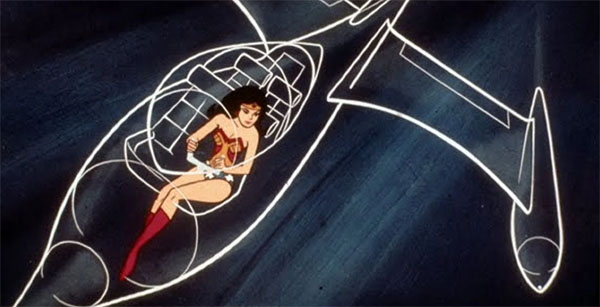
In the days of H-B’s move into the superhero genre, they would be responsible for bringing Wonder Woman into the run of the various “Superfriends” series, featuring on occasion her “invisible plane”, usually depicted to the camera as a series of dotted white lines. Cartoon Network would years later make the pointed observation, “If Wonder Woman’s plane is really invisible, how does she find it after she parks it for the night?”
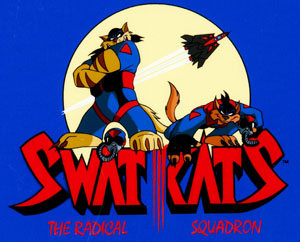 One of the studio’s last efforts, SWAT Kats: The Radical Squadron, centers on the exploits of rogue pilot cats Razor and T-Bone, in a futuristic jet constructed of spare parts from a salvage yard, known as the Turbokat. Having only recently viewed one episode, I am not in a position to give an overall appraisal of the series, and defer such task to the Wikipedia article based thereon. The animation looks like a cross between anime, Warner Batman/Superman style, and a few traditional elements, amounting to an uneasy mix of action-adventure, animated in a slightly-stilted style that resembles at times contemporary DIC product. Plotline of the premiere seemed reasonably well conceived for the day, though doing nothing yet to provide the characters’ backstory, and ending rather abruptly, seeming to leave several things unexplained. Weaponry of the aircraft seems to be left to the writers’ imaginations, including cement-shooting machine guns, octopus missiles (with tentacle style claw devices), and spider missiles (binding up their targets in lines of heavy cable). Amazing what you can construct from a junkyard with no budget. The lead characters seem to be cut of the same cloth as the Teenage Mutant Ninja Turtles, with lesser-defined personalities. And a relentless heavy-metal guitar score does little but to make the episode seem more chaotic than it needs to be. I probably wouldn’t have followed the series in its day, had I ever given it a fair chance by trying it out in the first place.
One of the studio’s last efforts, SWAT Kats: The Radical Squadron, centers on the exploits of rogue pilot cats Razor and T-Bone, in a futuristic jet constructed of spare parts from a salvage yard, known as the Turbokat. Having only recently viewed one episode, I am not in a position to give an overall appraisal of the series, and defer such task to the Wikipedia article based thereon. The animation looks like a cross between anime, Warner Batman/Superman style, and a few traditional elements, amounting to an uneasy mix of action-adventure, animated in a slightly-stilted style that resembles at times contemporary DIC product. Plotline of the premiere seemed reasonably well conceived for the day, though doing nothing yet to provide the characters’ backstory, and ending rather abruptly, seeming to leave several things unexplained. Weaponry of the aircraft seems to be left to the writers’ imaginations, including cement-shooting machine guns, octopus missiles (with tentacle style claw devices), and spider missiles (binding up their targets in lines of heavy cable). Amazing what you can construct from a junkyard with no budget. The lead characters seem to be cut of the same cloth as the Teenage Mutant Ninja Turtles, with lesser-defined personalities. And a relentless heavy-metal guitar score does little but to make the episode seem more chaotic than it needs to be. I probably wouldn’t have followed the series in its day, had I ever given it a fair chance by trying it out in the first place.
 Having fairly well covered the flight history of the HB studio, we turn now to some of its lesser rivals. Sam Singer’s Courageous Cat and Minute Mouse, while not notable for many things positive, deserves a mention as actually beating HB to the punch on the notion of a flying car, creating the Catmobile, which could sprout wings and fly in the same manner as Secret Squirrel’s later spy car. I’m pretty sure Courageous’s all-purpose cat gun was also used at least once with some kind of a helicopter-blade rotor attachment for the cat to remain airborne.
Having fairly well covered the flight history of the HB studio, we turn now to some of its lesser rivals. Sam Singer’s Courageous Cat and Minute Mouse, while not notable for many things positive, deserves a mention as actually beating HB to the punch on the notion of a flying car, creating the Catmobile, which could sprout wings and fly in the same manner as Secret Squirrel’s later spy car. I’m pretty sure Courageous’s all-purpose cat gun was also used at least once with some kind of a helicopter-blade rotor attachment for the cat to remain airborne.
Before Jonny Quest there was also Cambria Studio’s Clutch Cargo. Many of the basic elements of “Quest” were here in primordial form. Clutch, a pilot in many respects a dead ringer for Race Bannon (except for his “live” lips, provided by superimposing images of a real mouth upon the blank face drawing in what was called “Synchro-Vox.”) A boy (Spinner) and a pet dog (Paddlefoot). A plane to get them to the scene of adventure (not a jet, but a private twin prop cargo type plane). And a leaning toward semi-serious action adventure, though less violent and aimed at a younger audience than “Quest”. Even a “contemporary” and moody style of music was added by a three-instrument combo, composed by Paul Horn. Why didn’t it work so well, and why is it remembered in dire fashion today rather than affectionately as by Quest afficionados? The plots weren’t as creative or sophisticated. The villains weren’t as nefarious. And most of all – it just looks CHEAP, which it was. Nevertheless, one can hardly imagine that the eyes of Hanna-Barbera were not open to this early effort, and it would seem obvious that someone there saw some possibilities in the idea, if placed in the hands of a studio that could more competently accomplish the job.
Snyder-Koren Productions’ Roger Ramjet and His Eagles appears to have been strongly influenced by Jay Ward (whose work we’ll tackle in a subsequent article), at least in writing, loading episodes with topical pop-culture references of the day, and half-hearted reactions of the populace to Roger’s heroic exploits. But visually, the resemblance ends, with the simplistic low-budget “artwork”, making Jay Ward’s creations look comparatively like museum masterpieces. Ramjet, voiced in typical bravura fashion by Gary Owens, commands a squadron of jet fighter planes, assisted by junior pilots Yank, Doodle, Dan, and non-pilot sister Dee, fighting the forces of evil. It seems, however, that very little action essential to the plots takes place in the planes, which are mainly used to get from point A to point B. Budget limitations seem an obvious reason for this lack of actual flight time – and also the fact that Roger’s ace-in-rhe-hole “spinach can” was a proton energy pill that provided him with the strength of 20 atom bombs for 20 seconds – a power more easily unleashed on the ground than in the cockpit of a plane. Thus, Roger may have been one of the most commonly “grounded” pilots of his day in the animated world.
Format Films provides two episodes of note. Produced under contract for King Features Syndicate, Popeye’s I Bin Sculped follows in the footsteps of the theatrical episodes Hospitaliky and For Better or Nurse. Sculptor Olive Oyl taps away at a huge block of granite, only to produces therefrom a small stone sign reading “Model Wanted.” Popeye and Bluto (here known as Brutus) both answer to the call, getting stuck as usual in the door jamb bickering as to who is the better artistic subject. To their surprise, Olive turns them both down, saying she doesn’t want a strong man, but a weak one, who is a physical mess, for a statue entitled “Pooped.” The boys rival to see who can become the most messed mess.
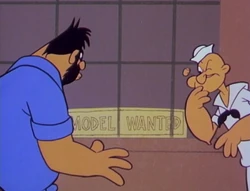 Popeye lays down in front of a steamroller, but Bluto drags him to safety from a manhole just in time. Bluto dives off the top of a 104-story skyscraper. Popeye intervenes, first with a safety net out a window (which Bluto snips through with a pair of scissors on the way down), then a barrel full of rain water at the pavement below. Popeye paints himself red in front of a mad bull, but Bluto pours upon him from above a bottle of invisible ink, making the bull miss him entirely. Finally, Bluto goes to buy a rickety old biplane, only to find new owner Popeye already working under the hood. “Who was ya expectin’. Orville Wright?”, wisecracks Popeye. If you can’t buy it, steal it. So Bluto socks Popeye into a wind sock, and takes off. Popeye remarks that Bluto’s “gonna hurt himself if I’m not careful.” Popeye races along the street grid below while Bluto’s plane criss-crosses the city, hollering up to Bluto. “Don’t just do something, stand there.” But Bluto jumps, falling smack onto Popeye, leaving them both in a crater in the sidewalk, directly in front of Olive’s studio. Olive emerges to see an unconscious and ragged Bluto on top, and announces he’s the perfect mess for the statue. Until the hand of Popeye emerges from under Bluto, holding a spinach can. As in the predecessor episodes, the spinach is poured down Bluto’s throat. Bluto suddenly pops to life, restored to his old health and vitality, and then some. He begins socking away at Popeye, his head popping out of a fight cloud to explain to the audience “I can’t help myself.” Work on the statue thus commences with Popeye as subject – black-eyed, bandaged in half-traction, and on crutches. Popeye performs his usual last bars of his theme song, referring to himself as “Poop-eye the sailor man.”
Popeye lays down in front of a steamroller, but Bluto drags him to safety from a manhole just in time. Bluto dives off the top of a 104-story skyscraper. Popeye intervenes, first with a safety net out a window (which Bluto snips through with a pair of scissors on the way down), then a barrel full of rain water at the pavement below. Popeye paints himself red in front of a mad bull, but Bluto pours upon him from above a bottle of invisible ink, making the bull miss him entirely. Finally, Bluto goes to buy a rickety old biplane, only to find new owner Popeye already working under the hood. “Who was ya expectin’. Orville Wright?”, wisecracks Popeye. If you can’t buy it, steal it. So Bluto socks Popeye into a wind sock, and takes off. Popeye remarks that Bluto’s “gonna hurt himself if I’m not careful.” Popeye races along the street grid below while Bluto’s plane criss-crosses the city, hollering up to Bluto. “Don’t just do something, stand there.” But Bluto jumps, falling smack onto Popeye, leaving them both in a crater in the sidewalk, directly in front of Olive’s studio. Olive emerges to see an unconscious and ragged Bluto on top, and announces he’s the perfect mess for the statue. Until the hand of Popeye emerges from under Bluto, holding a spinach can. As in the predecessor episodes, the spinach is poured down Bluto’s throat. Bluto suddenly pops to life, restored to his old health and vitality, and then some. He begins socking away at Popeye, his head popping out of a fight cloud to explain to the audience “I can’t help myself.” Work on the statue thus commences with Popeye as subject – black-eyed, bandaged in half-traction, and on crutches. Popeye performs his usual last bars of his theme song, referring to himself as “Poop-eye the sailor man.”
Format’s other notable achievement was an installment for The Alvin Show’s second-string series, an original and creative study of a “great inventor” (whom Alvin can’t even recall in an introductory bumper, believing he should be introducing Thomas Edison, Alexander Graham Bell, or Wilbur and Orville Wright). The inventor is the lovable but conceited dunderhead, Clyde Crashcup, voiced be Shepard Menkin in his closest approximation of Richard Haydn, and ably assisted by his more common-sensical but silent partner Leonardo, who communicates only in whispers. Crashcup had a few gimmicks. First, he rarely stooped to manual labor to build his inventions, but had either designed or acquired what may have been his only real invention of worth – a pencil, with which he can draw on any wall, and have his design instantly transform into full color three-dimensional life (massively saving time on product development). The pencil’s creations not only include inanimate objects, but living, breathing beings, ranging from weird animals to “the wife”, a baseball umpire, etc. Crashcup’s second trait was that he always uselessly “invented” things that other people had invented already. I suppose some credit may be due for independent creation without infringement upon or knowledge of the original, but it is obvious that these incidents are not flashbacks in time, as Crashcup (including in this episode) sometimes has run-ins with the more advanced products of competing inventors of the current day. The series was a dependable laugh-getter, livening up and well-rounding out things between the chipmunks’ musical antics.
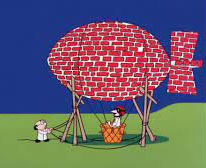 In Crashcup Invents Flight (11/29/61), Clyde is asleep on a couch, when two flies begin playing a walking game of “Ring Around a Rosy” around his eyeballs. “Leonardo, the fly swatter”, he calls. Little Leonardo appears, and smacks the flies good, leaving imprint of the swatters latticed design across Clyde’s face. Well, no sleeping under these conditions, so there’s work to be done. Crashcup studies one of the swatted flies under a microscope, and asks Leonardo to have a look also and tell him what he sees. Leonardo whispers, “A dead fly.” “No, Leonardo”, responds Crashcup disdainfully, pointing out instead the fly’s wing structure. He asks, “What can flies do that man cannot do?” Leonardo’s whispered response is again off base – “Walk upon the ceiling.” Of course, Crashcup is only concerned with flight, concluding “The wing is the thing.” Grabbing up his pencil, Clyde designs a large pair of strap-on fly wings, human sized. “If flies can fly, so can I.” He advances to the roof, while cautious Leonardo pulls out a butterfly net to hold below. Crashcup scoffs at his assistant’s lack of faith, and begins flapping. His wing straps fail to hold, and the devices have parted from his arms before he even reaches the roof edge. His only progress is directly down, landing face first in Leonardo’s butterfly net.
In Crashcup Invents Flight (11/29/61), Clyde is asleep on a couch, when two flies begin playing a walking game of “Ring Around a Rosy” around his eyeballs. “Leonardo, the fly swatter”, he calls. Little Leonardo appears, and smacks the flies good, leaving imprint of the swatters latticed design across Clyde’s face. Well, no sleeping under these conditions, so there’s work to be done. Crashcup studies one of the swatted flies under a microscope, and asks Leonardo to have a look also and tell him what he sees. Leonardo whispers, “A dead fly.” “No, Leonardo”, responds Crashcup disdainfully, pointing out instead the fly’s wing structure. He asks, “What can flies do that man cannot do?” Leonardo’s whispered response is again off base – “Walk upon the ceiling.” Of course, Crashcup is only concerned with flight, concluding “The wing is the thing.” Grabbing up his pencil, Clyde designs a large pair of strap-on fly wings, human sized. “If flies can fly, so can I.” He advances to the roof, while cautious Leonardo pulls out a butterfly net to hold below. Crashcup scoffs at his assistant’s lack of faith, and begins flapping. His wing straps fail to hold, and the devices have parted from his arms before he even reaches the roof edge. His only progress is directly down, landing face first in Leonardo’s butterfly net.
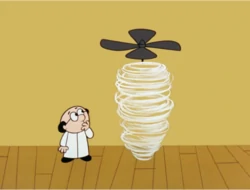 “Am I not smarter than a fly?”, Crashcup asks. Like Jack Benny when asked to choose between “Your money or your life”, Leonardo pauses to think that one over. Crashcup insists his inventive brain is whirling, whirling…and hits on the idea for the “whirling wing” – essentially, a propeller beanie with engine atop a football-styled strapped helmet. Starting up the engine, his device’s propeller behaves as a precursor to Smedly’s copter-cap in “Fractured Friendship”, staying motionless, while its wearer is corkscrewed into the ground – then detaches to fall with a clunk onto Clyde’s head. Clyde tries it again, asking Leonardo to hold his feet so that the wing, not himself, will spin. Somehow, Clyde’s head follows the twirling of the blade above, winding his body up into a braid. “Let go, Leonardo”, Crashcup tremulously cries. Now Crashcup twirls, stumbling about the room in a dizzy walk, then having the propeller blade crash upon his head again.
“Am I not smarter than a fly?”, Crashcup asks. Like Jack Benny when asked to choose between “Your money or your life”, Leonardo pauses to think that one over. Crashcup insists his inventive brain is whirling, whirling…and hits on the idea for the “whirling wing” – essentially, a propeller beanie with engine atop a football-styled strapped helmet. Starting up the engine, his device’s propeller behaves as a precursor to Smedly’s copter-cap in “Fractured Friendship”, staying motionless, while its wearer is corkscrewed into the ground – then detaches to fall with a clunk onto Clyde’s head. Clyde tries it again, asking Leonardo to hold his feet so that the wing, not himself, will spin. Somehow, Clyde’s head follows the twirling of the blade above, winding his body up into a braid. “Let go, Leonardo”, Crashcup tremulously cries. Now Crashcup twirls, stumbling about the room in a dizzy walk, then having the propeller blade crash upon his head again.
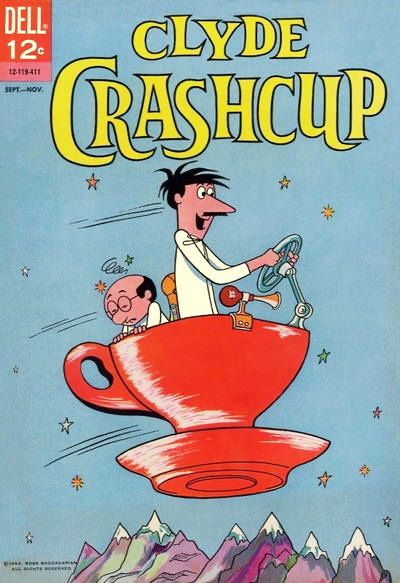 Still convinced that the whirling wing is on the right track, Clyde decides a modification is in order for more power. He designs the aircraft engine block with prop on the front for drive, and adds his arm-strap wings for lift. As Clyde has provided no fuselage for the device, Leonardo supplies a seat by placing horse saddle atop the engine. Clyde has Leonardo push a starter button, and set the thing into gear, while he himself dons the wings and a pair of pilot’s goggles. The engine zooms forward, right through the wall, losing in the process both Crashcup’s wings and the horse saddle. Crashcup zooms around helplessly in the sky with the engine block, riding bareback as if on a bucking bronco, then backwards, then hanging on underneath, upside down, and even with a seagull as passenger atop his head. Crashcup’s jaw hangs agape, as he encounters a formidable obstacle – a modern passenger jet, heading straight for him. Clyde and the engine disappear into the jet’s air intake – and come out the exhaust, broken into a pile of nuts and bolts. Leonardo races underneath with a wheelbarrow as Crashcup falls. landing with enough force that the inverted wheelbarrow now looks like a cup for Clyde.
Still convinced that the whirling wing is on the right track, Clyde decides a modification is in order for more power. He designs the aircraft engine block with prop on the front for drive, and adds his arm-strap wings for lift. As Clyde has provided no fuselage for the device, Leonardo supplies a seat by placing horse saddle atop the engine. Clyde has Leonardo push a starter button, and set the thing into gear, while he himself dons the wings and a pair of pilot’s goggles. The engine zooms forward, right through the wall, losing in the process both Crashcup’s wings and the horse saddle. Crashcup zooms around helplessly in the sky with the engine block, riding bareback as if on a bucking bronco, then backwards, then hanging on underneath, upside down, and even with a seagull as passenger atop his head. Crashcup’s jaw hangs agape, as he encounters a formidable obstacle – a modern passenger jet, heading straight for him. Clyde and the engine disappear into the jet’s air intake – and come out the exhaust, broken into a pile of nuts and bolts. Leonardo races underneath with a wheelbarrow as Crashcup falls. landing with enough force that the inverted wheelbarrow now looks like a cup for Clyde.
Clyde changes course entirely for his final invention, actually building for once his design by physical effort, atop a large wooden scaffolding. Shifting to the principles of ballooning, Clyde constructs a dirigible – out of solid bricks! He attempts to embark on “the first heavier-than-air flight”, with expected results as the scaffolding is pulled away – a crumbling crash onto Crashcup and Leonardo. Clyde emerges bruised, with the glass shattered out of his flight goggles. “We have failed. Failed miserably. Oh, what is the answer?” Leonardo whispers words of wisdom into his ear, which even Clyde has to admit are sound and logical. “Ladies and Gentlemen”, he announces, “Flying is for the birds!”
Format would finally include a brief shot of flying in the opening titles sequence of “The Alvin Show”, with Alvin in a biplane, facing an oncoming squadron of enemy planes. He blasts through in an explosion, and suddenly, all the opposing planes are converted to just pilots descending with parachutes, as Alvin gives them a victorious wave from his plane.
Disney wings its way through the television era, next time.
